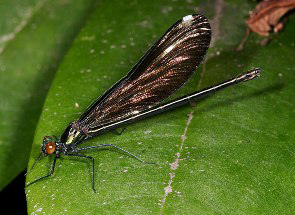Ebony jewelwings are the most common and widespread damselflies in North America. Other than the smoky rubyspot (Hetaerina titia ), they are the only damselflies in North America that have completely dark wings.
Photo Credit: Paul McNelis
Calopteryx maculata
Common Name: ebony jewelwing
Other Common Names: black-winged damselfly
Animal Guild: Insect
Class > Order > Family: Insecta > Odonata > Calopterygidae
What does the species look like?
Both sexes: Damselflies are generally delicate and small-bodied with narrow abdomens, their heads are wider than they are long, and their eyes are separated without touching. Their wings are held either pressed together above the body or partially open at rest. The wings are entirely black and are broader than other jewelwings. The legs of both sexes are long and black, and have prominent spines.
Males: The male thorax and abdomen are brilliant, metallic green (appearing blue when backlit) over a base of black. The head is iridescent blue-green. Older, mature males have unmistakeably solid black wings, while the wings of younger damselflies are lighter and browner.
Females: The female is more bronzy on the body with a thicker abdomen and dark brown dusky wings with conspicuous white spots on the leading edge of the wings near the wing tip.
Total length: 37-57 mm; abdomen: 30-47 mm; hindwing: 25-37 mm
Similar Species: Smoky rubyspot (Hetaerina titia ) is the only other damselfly that may have completely dark wings. It lacks the blue-green iridescence on the body and the wings are only about a fifth as wide as long. In the sparkling jewelwing (Calopteryx dimidiata ) only the apical third or less of the wings are black. All other jewelwings have narrower, paler wings.
Where is the species found?
States & Provinces
AL, AR, CO, CT, DE, FL, GA, IA, IL, IN, KS, KY, LA, MA, MB, MD, ME, MI, MN, MO, MS, MT, NB, NC, NE, NH, NJ, NS, NY, OH, OK, ON, PA, PE, QC, RI, SC, SD, TN, TX, VA, VT, WI, WV
Distribution
Range: Central to eastern United States and into southeastern Canada.
Although this species occurs in a variety of streams and small rivers, it is most common along shallow, forested streams. Adults perch on streamside and emergent vegetation within a few feet of the water. They fly low over the water or along forest paths in a bouncy, butterfly-like manner. It is the only jewelwing likely to wander well away from water.
General Phenology and Life History
The flight period varies from February to December in the southern region, to May to September in central and northern regions.
Which phenophases should I observe?
Do you see/hear...?
Activity
Adults More...
For abundance, enter the number of individual animals observed in this phenophase.
Adults feeding Calopteryx maculata , adults feed on almost any flying insect they can catch.
For abundance, enter the number of individual animals observed in this phenophase.
Reproduction
Mating For abundance, enter the number of individual animals observed in this phenophase.
Egg laying For abundance, enter the number of individual animals observed in this phenophase.
Development
Recently emerged adults For abundance, enter the number of individual animals observed in this phenophase.
Dead adults For abundance, enter the number of individual animals observed in this phenophase.
Method
Individuals at a light For abundance, enter the number of individual animals observed in this phenophase.
Individuals in a net For abundance, enter the number of individual animals observed in this phenophase.
Individuals in a trap For abundance, enter the number of individual animals observed in this phenophase.
What do these phenophases look like?
There is currently no photoguide available for this species. If you'd like help us create one, use the guidance document and species template provided here . Then send it via email to education@usanpn.org when it is complete.
